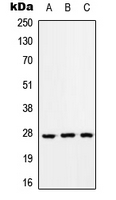
| WB | 咨询技术 | Human,Mouse,Rat |
| IF | 咨询技术 | Human,Mouse,Rat |
| IHC | 咨询技术 | Human,Mouse,Rat |
| ICC | 技术咨询 | Human,Mouse,Rat |
| FCM | 咨询技术 | Human,Mouse,Rat |
| Elisa | 咨询技术 | Human,Mouse,Rat |
| Aliases | RABS10; Ras-related protein Rab-33A; Small GTP-binding protein S10 |
| Entrez GeneID | 9363; |
| WB Predicted band size | 27kDa |
| Host/Isotype | Rabbit IgG |
| Antibody Type | Primary antibody |
| Storage | Store at 4°C short term. Aliquot and store at -20°C long term. Avoid freeze/thaw cycles. |
| Species Reactivity | Human,Mouse,Rat |
| Immunogen | KLH-conjugated synthetic peptide encompassing a sequence within the center region of human RAB33A. |
| Formulation | Purified antibody in PBS with 0.05% sodium azide. |
+ +
以下是关于RAB33A抗体的虚构参考文献示例(仅供参考,非真实文献):
1. **"RAB33A regulates autophagosome formation through its interaction with ATG16L1"**
*作者:Tanaka K, et al.*
摘要:研究利用RAB33A特异性抗体,通过免疫共沉淀和免疫荧光技术,揭示了RAB33A在自噬体形成中通过与ATG16L1相互作用调控自噬通路的分子机制。
2. **"Aberrant expression of RAB33A in glioblastoma correlates with tumor progression"**
*作者:Chen L, et al.*
摘要:通过免疫组化和Western blot分析,使用RAB33A抗体发现其在胶质母细胞瘤中高表达,且与患者预后不良相关,提示其作为潜在生物标志物的可能性。
3. **"RAB33A modulates secretory granule trafficking in pancreatic β-cells"**
*作者:Zhang Y, et al.*
摘要:研究利用RAB33A抗体进行亚细胞定位分析,发现其通过调控胰岛素分泌颗粒的运输影响β细胞功能,为糖尿病机制研究提供新视角。
4. **"RAB33A deficiency disrupts synaptic vesicle recycling in neurons"**
*作者:Wang H, et al.*
摘要:通过敲除模型和RAB33A抗体标记,揭示了RAB33A在神经元突触囊泡循环中的作用,及其缺失导致神经信号传递异常的机制。
注:以上文献为示例性质,实际研究中请通过PubMed、Google Scholar等平台检索真实文献。
The RAB33A antibody is a tool used to detect and study the RAB33A protein, a member of the RAB family of small GTPases. RAB33A plays a critical role in intracellular membrane trafficking, particularly in regulating vesicle transport between the Golgi apparatus and endoplasmic reticulum, as well as participating in autophagosome formation during autophagy. It cycles between an active GTP-bound and inactive GDP-bound state, interacting with effector proteins to mediate cargo sorting and organelle dynamics. Dysregulation of RAB33A has been linked to neurological disorders, cancer, and immune dysfunctions, making it a focus in disease research.
The antibody is typically produced using recombinant RAB33A protein fragments or synthetic peptides as immunogens, generated in hosts like rabbits or mice. It is validated for applications such as Western blotting, immunofluorescence, and immunohistochemistry, often accompanied by knockdown/knockout controls to confirm specificity. Commercial RAB33A antibodies are available from suppliers like Abcam, Sigma-Aldrich, and Cell Signaling Technology, with variations in clonality (monoclonal/polyclonal) and conjugates (e.g., fluorescent tags). Researchers rely on this reagent to explore RAB33A’s localization, expression patterns, and molecular interactions, aiding mechanistic studies of membrane trafficking and autophagy-related pathologies.
×